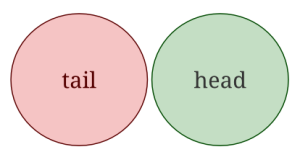Everyone has an intuitive concept of chance/probability. When we say that there is a certain probability of an event happening, what do we mean?
First, you need to understand the concept of an “event”. An event is one possible outcome of some probabilistic scenario. Say you are flipping a coin. The two possible events are “heads” and “tails” (though I guess you could argue that there is a third event: “coin lands on its edge”). As you will see in Axiom #3, since a coin cannot land on both “heads” and “tails, “heads” and “tails” are mutually exclusive.
There are three axioms upon which probability theory is built:
1. Let be the probability of an event. Then
. The probability of any event is between 0 and 1.
2. Let be the set of all possible events. Anything that could possibly happen is contained in
.
. The probability of some event happening is 1.
3. Let ,
, …,
be a sequence of mutually exclusive events. Two events are mutually exclusive if only one of the two can happen at any time.
. This says that you can add the probabilities of two or more mutually exclusive events together to get the probability of any one of them happening.
With these three axiomatic building blocks, all of probability theory can be built.

Pingback: Theory Thursday- Conditional Probability | Eric Webb